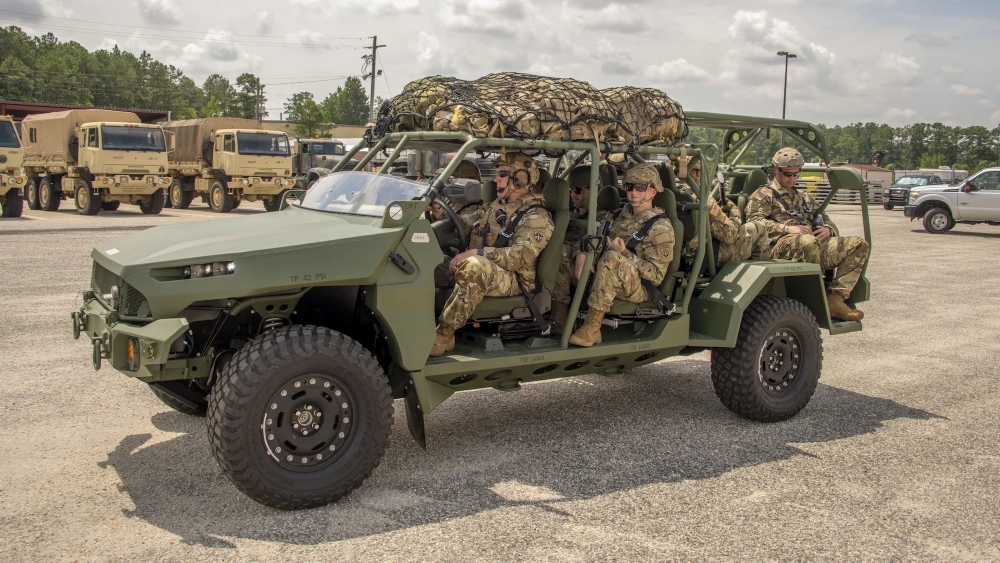
A vast program of change and modernization is coming for the US Army, driven by an official memo by Secretary for Defense Peter Brian Hegseth dated 30 April and followed by an official letter co-signed by General Randy George, Chief of Staff and by the Army Secretary Dan Driscoll.
The instructions in Hegseth’s memo are clear and in line with already known priorities of the Trump administration, in particular because of the focus on the Indo-Pacific theatre.
The modernization of the army is to be driven by fielding “long-range missiles capable of striking moving land and maritime targets by 2027”. This will be achieved primarily, but probably not only, through the Precision Strike Missile (PrSM) Increment 2. The $150 billion supplemental bill being pushed for the FY 2025 budget by the Republicans includes other measures including adding a suitable seeker also to the GMLRS Extended Range rocket.
The Army will have to increasingly look towards the sea and littorals, and well as electromagnetic warfare, to achieve “electromagnetic and air-littoral dominance by 2027”.
Improved Counter-UAS capability must by integrated “into maneuver platoons by 2026 and maneuver companies by 2027”, interestingly suggesting a bottom-up approach building the capability upwards from the lowest tactical echelon.
Artificial Intelligence will be used to improve Command and Control “at Theater, Corps, and Division headquarters by 2027”.
Investment will go into greater use of advanced manufacturing, including 3D printing and additive manufacturing within operational units already by 2026, to improve logistics.
The industrial base will be further modernized to “generate the ammunition stockpiles necessary to sustain national defense during wartime by implementing 21st-century production capabilities, with full operational capability by 2028”.
The Army is being tasked to increase its forward presence in the Indo-Pacific by “expanding pre-positioned stocks, rotational deployments, and exercises with allies and partners to enhance strategic access, basing, and overflight”.
The Army will have to “merge headquarters to generate combat power capable of synchronizing kinetic and non-kinetic fires, spaced-based capabilities, and unmanned systems”.
To help resource these investments, the Army will end or scale back “ineffective or redundant programs, including manned aircraft, excess ground vehicles (e.g., HMMWV), and outdated UAVs”. It will also “reduce and restructure manned attack helicopter formations and augment with inexpensive drone swarms capable of overwhelming adversaries”.
It will also have to identify “outdated formations, including select armor and aviation units across the Total Army (Active, Reserve, National Guard)” that will be divested. Forces will have to be “Realign(ed) strategically to optimize deterrence and rapid deployment, above all to defend the American homeland and deter China in the Indo-Pacific”.
Among HQs that will have to “downsize, consolidate or close”, it has been decided to merge the Army Futures Command (AFC) and Training and Doctrine Command (TRADOC) into one. A unified Western Hemisphere Command will be formed by merging the current US Army North and US Army South Commands. Hegseth’s memo also orders the restructuring of the sustainment enterprise “by consolidating and realigning headquarters and units within Army Material Command, including the integration of the Joint Munitions Command and Army Sustainment Command, to optimize operational efficiency and streamline support capabilities”. A review is ordered to look at consolidating operations “across select depots, arsenals, and installations and look for leasing opportunities with commercial entities seeking to expand into the Defense Industrial Base”.
Obviously, Hegseth’s memo has caused great curiosity as to what programs will be cancelled or scaled back and which ones remain prioritary. The letter by the Army Secretary and Chief of Staff does shed some additional light: the development of a lighter, more capable ABRAMS M1E3 is a named priority, with the Future Long Range Assault Aircraft being the other.
It is also reaffirmed that “all” Infantry Brigade Combat Teams will be transformed into Mobile BCTs through the increased mobility assured by the Army Infantry Squad Vehicle (ISV).
Army Aviation will be restructured with all Active Component Combat Aviation Brigades losing their Aerial Cavalry Squadron. Readers will probably remember that the insertion of an Aerial Cavalry Squadron in each CAB followed the deletion of the KIOWA WARRIOR scout helicopter. The addition of the ACS doubled the number of AH-64 APACHE gunships in each CAB (from 24 to 48).
If interpreted literally, this measure would effectively halve the number of Attack Helicopter battalions. The letter specifically mentions “cancel the procurement of outdated crewed attack aircraft such as the AH-64D” and “obsolete UAVs like the GRAY EAGLE”.
The AH-64D is, of course, no longer being “procured” but a substantial number of this older type remains in use and was expected to remain in the force until 2031. This will probably now swiftly change. The AH-64E is not mentioned and should not be affected, especially since its procurement is also essentially finishing: the 38 aircraft remanufactures (AH-64D stripped and rebuilt inside new fuselages to become AH-64Es) requested within the Fiscal Year 2025 Budget are the last in the program, while the procurement of fully new-build AH-64E was concluded years ago.
Official US Army data supplied to Congress shows that, as of 2023, the inventory included 229 AH-64D and 486 AH-64E. In the meanwhile, the number of Ds will have shrunk further, with the number of Es increasing. Assuming the 31 remanufactures in 2025 are not cancelled, the program will have remanufactured a total of 622 helicopters once fully delivered, plus 79 new builds.
This is short of the Army Procurement Objective that, between remanufacture and new builds, was 791 but should keep Army aviation in good health.
The exact impact on the MQ-1C GRAY EAGLE will have to be discovered over the coming months. The US Army is no longer procuring new drones of this type (the last 12, of a total of 298, were ordered in FY 2023) but does have ongoing programmes for mission payloads, upgrades and modifications. Some thinking has already been ongoing for some time about what kind of drone could next be acquired to provide long range ISR for Corps level of command and the designation of GRAY EAGLE as “obsolete” (despite the pushback of its manufacturer, General Atomics) will probably add urgency to these discussions.
The letter by the Army Secretary and Chief of Staff also adds another illustrious name to the list of programmes to be cancelled or scaled back: where Hegseth’s memo mentioned the sole HMMWV, this letter also names the JLTV, describing both as “excess ground vehicles”.
Again, it will have to be seen what the actual decisions will be. The ongoing procurement of HMMWVs is a very modest voice of expenditure in the annual budget as its objective is allowing the divestiture of the oldest, non-armored vehicles of the type, replacing them with new production M1152A1/M1165A1 armored and armor-capable HMMWVs. The Fiscal Year 2025 budget includes just 5.26 million USD for 16 M1165A1B3. There is also, of course, an ongoing program of mechanical modifications (embodiment of Anti-lock Braking System/Electronic Stability Control (ABS/ESC) Systems, Heating, Ventilation and Air Conditioning (HVAC), and Alternating Current (AC) Inverter) which could suffer cutbacks, but we should wait and see to discover the actual decisions as it is difficult to imagine how thousands and thousands of vehicles can simply be divested without a clear alternative for how to move what they currently carry.
The exact same reasoning must be applied to the JLTV. With a long term procurement objective of 49,099 vehicles and 18,224 trailers, it is difficult to imagine the project simply disappearing. The guess we can offer is that the prime candidates for cutbacks are not so much the General Purpose and Utility variants but perhaps the Heavy Guns Carrier and the Close Combat variant. It is relatively easy to imagine “better” ways to bring to bear heavy weapons and machineguns (robotic vehicles, for example) than with a JLTV.
A program that is never mentioned in either letter as published but which has publicly condemned later at a roundtable with the press, with both the Army Secretary and Chief of Staff coming out against it, is the M10 BOOKER “light” tank (Mobile Protected Firepower). This vehicle was allowed to grow too large and too heavy and essentially no longer delivers the original vision for it, and is not thought to be a good investment.
Other programs are being named for cuts in a less reliable way. An unnamed “defense officer” has reportedly indicated that the Armored Multi Purpose Vehicle (AMPV) is also going to be cancelled, or perhaps scaled back to the “very minimum” sustainable production rate (which FY 2025 documentation suggest would be 5 vehicles per month). Said officer reportedly said that AMPV is “just a box on tracks” and is not wanted because a robotic vehicle could do its job instead. We report this, but can’t help but note that the AMPV is produced in Mission Command, Medical Evacuation, Medical Treatment, General Purpose and Mortar variants. Most recently, the mortar variant was “moving” towards adoption of a Patria NEMO automated mortar in turret rather than the mortar on turntable firing through hatch used and planned so far.
It’s honestly difficult to imagine how, and when, a robotic vehicle or a different vehicle solution could actually replace command posts, ambulances and medical treatment vehicles. Putting the mortar on a crewless platform might be feasible, but we wait and see if / how the AMPV will truly be affected.
The STRYKER 8x8 is also reported to be cutback in some way. At present, STRYKERs are still being procured each year in order to replace old, flat-bottom vehicles with Double V Hull (DVH) A1 Engineer Change Proposal (ECP) standard vehicles.
We will of course observe the next developments.








.png)
